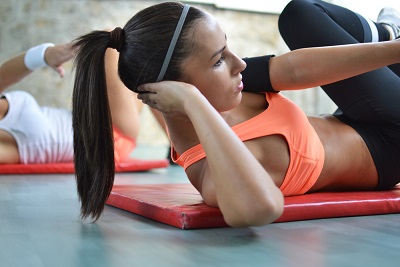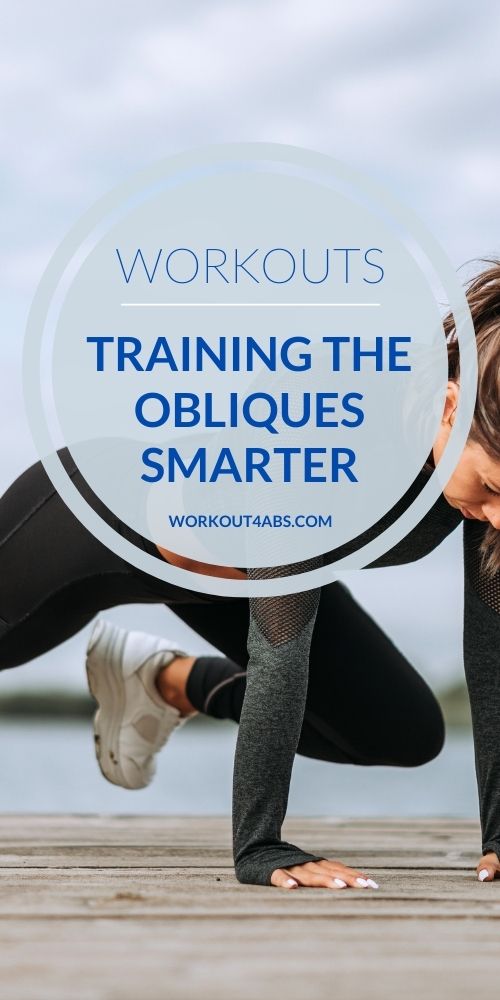No Oblique Crunches on the Floor
Oblique crunches on the floor aren’t going to develop that midsection you’ve always wanted.
Just like dozens of other ab exercises to work into your program, the oblique crunch has it’s appropriate time and place.

Best Internal/External Oblique Exercises
Some ab exercise techniques are more appropriate than others. Crunches certainly aren’t the answer for everyone. It depends on the individual.
There are many reasons oblique crunches on the floor aren’t the best way to work the obliques.
First, when is comes to how to train the obliques, consider the position of the spine.
Neutral Spine is a term that refers to the position the spine is in when you are performing an exercise.
You’ve probably heard a trainer or strength coach professional talk about how important it is to have a neutral spine when performing a strength training exercise.
Staying “neutral” doesn’t mean that the spine stays completely straight.
The spine has a tolerable range of anterior tilt, also called lordotic curve. Then there is also a tolerable range of kyphosis (rounding) of the upper back.
The spine has natural curves, resembling an “S” shape. Today, this “S” shape of the spine is considered normal.
Start by Training “Neutral Spine”
It’s important to note that if you have any issues related to Upper-Crossed Syndrome or Lower-Crossed Syndrome, then you need to tackle these problems right way.
Addressing these issues immediately saves you time because you’re less likely to suffer from painful workouts. Not creating injuries and staying pain free is critical to advancing further with your ab training.
Not to mention the better your body alignment, the better you’ll feel, and the more you’ll want to train because you’ll be enjoying your workouts a whole lot more!
Upper/Lower Crossed Syndrome
If you aren’t familiar with the concept of Upper-Crossed/Lower-Crossed Syndrome, here’s a basic explanation.
Stretch what is tight (stiff or short muscles), and strengthen what’s weak or inhibited.
For the lower body, it’s usually the glutes and anterior core. For problems with the upper body, it’s usually tightness of the upper traps, scapula, pec major, and pec minor. Upper body weakness are usually at the cervical flexors, mid and lower traps.
Before you pound away at oblique crunches on the floor, learn how to exercise the obliques and also the technique for getting into the neutral spine position.
Kyphosis Upper Back
First, tackle the upper back with some aggressive foam rolling. If you have issues, you likely need to start by breaking up soft tissue in the upper back with some Thoracic Spine Mobilization.
You need exercises that work both Rotation and Extension.
1. Side Lying Windmills
2. Quadraped Extension Rotation
3. Side Lying Rib Rolls
4. Bent Over T-Spine Rotation
Lordosis Lower Back
For a hyperlordotic back, improve your breath with breathing techniques that strengthen the diaphram. Improving pelvic control along with work of the internal/external obliques will go along way to correcting hyperlordosis.
One of the rectus abdominis main job is to posterioraly tilt the pelvis. This indvertently results in the pulling of the sternum closer to the pelvis. For this reason, you should be careful not to do a ton of crunches or sit-ups.
A better alternative is to focus on the reverse crunch. Reverse crunches work the external/internal obliques better than traditional oblique crunches on the floor.
The reverse crunch also posteriorly tilts the pelvis.
The advantage here is that you are getting back closer to “neutral” spine without the hindrance of traditional crunches and sit-ups.
1. Split Stance Cable Lifts
2. Slideboard Bodysaws
If you enjoyed these tips and would like to keep it close to you at any time, just save this pin to your Pinterest Ab Training Board.

Home › How to Crunch ›Oblique Crunches on the Floor